I wanted to see how my new FE 2/28 compares against my older manual lenses, so I ran a comparison between four lenses:
- The Minolta MD 2.8/28 is very small, light and affordable
- The Carl Zeiss Distagon 2.8/28 T* enjoys a very good reputation and it is a bit more expensive at around 250€.
- The Minolta MC 2/28 is the oldest and fastest of the bunch, it was introduced in 1975. My copy has some fungus in it and other copies might be better.
- The Sony FE 2/28 is brand new and the most expensive one at 450€.

A note on the test
All the images are processed raws with my usualy settings, for every scene all lenses received identical processing.
All images were taken from a tripod. All images are taken at f/2.8, the only exception is the infinity test.
All images can be found in full resolution on flickr in this set.
Short distance
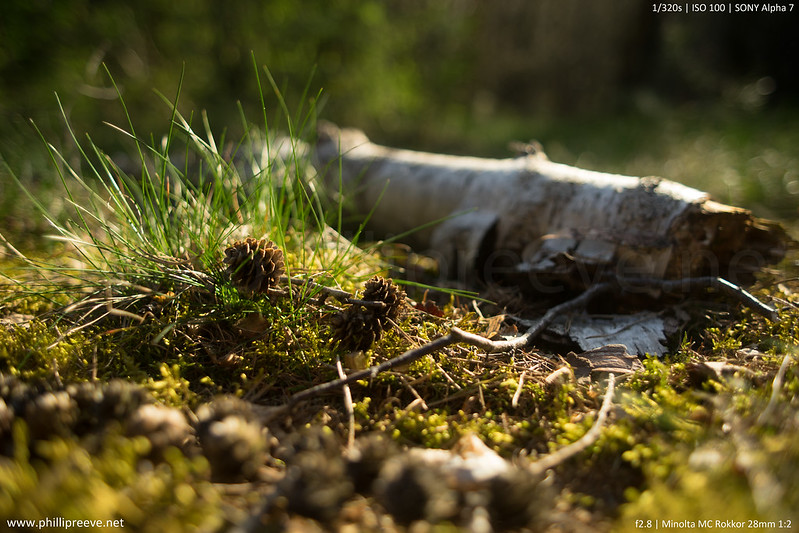
Center Sharpness
- The FE 2/28 and the Zeiss fare best here
- Both Minoltas are a little less sharp
All lenses perform very similar, I think I like the Minolta 2/28 the best but only by a small margin
- The Sony has the smoothest bokeh but also the most obvious LoCA
- The Minolta MC 2/28 has very large blur disks with very little contrast.
- Both 2.8/28 lenses have very hard edges
Mid Distance
- Sony FE and Zeiss Distagon lead the bunch with very nice micro contrast
- The MD 2.8/28 is a little less sharp but still good enough
- The MC 2/28 makes a clear last place, the fungus in the lens might play a role here
- The Sony is again a clear winner
- the other lenses perform very similar – not very good
All lenses are not very good here.
Distortion
lets have a look at distortion the three manual 28’s performed quite simliar and showed a little barrel distortion
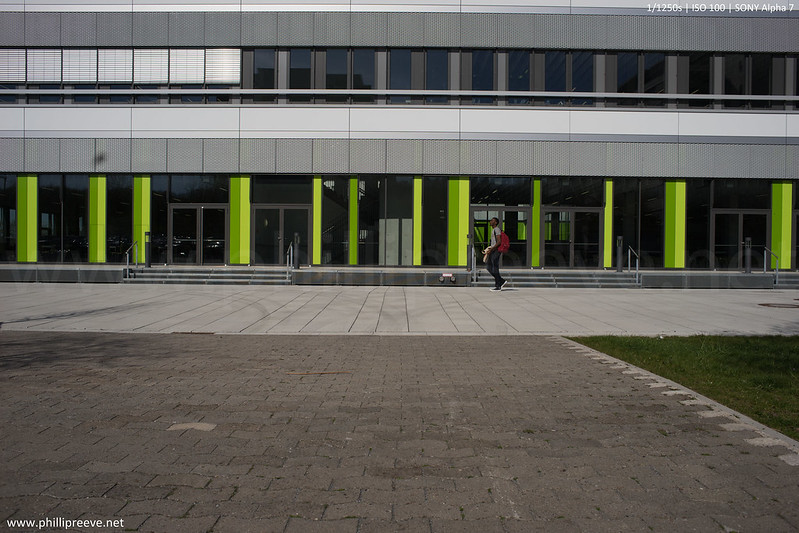
The Sony on the other hand shows impressive distortion. Not impressive in a positive way though. Another aspect is that it shows a wider field of view, so the corrected images has a field of view of a 28mm. This costs some resolution though.
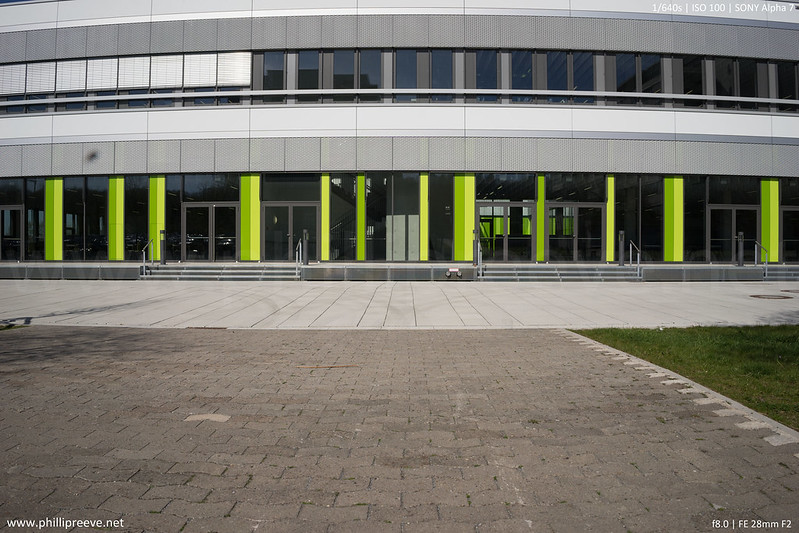
I think this is an acceptable tradeoff, you can correct distortion easily but it costs some resolution. So far I haven’t had to correct a single landscape image for distortion but if you are a demanding architecture photographer you might have a different opinion.
Sharpness Infinity
- Sony FE 2/28 – by f/8 it is the only lens with very good across the frame sharpness. At faster apertures very have a very sharp center, the rest of the image is noticeably less sharp but it does not really deteriorate towards the corners
- Zeiss Distagon 2.8/28 – At f/2.8 and f/4 it has a better midframe performance than the Sony FE lens but the corners are worse. At f/8 the Minoltas are clearly inferior and 98% of the image is very sharp. The last few pixels in the corners deteriorate quite a bit.
- Both Minoltas require f/11 for good across the frame sharpness and the Zeiss is much better at faster apertures.
Conclusion
The Sony FE 2/28 performed remarkably well in this test, it has by some margin the best bokeh and it is as sharp as the Zeiss 2.8/28 with even better corners. It also is the most flare resistant and it is one stop faster than the Zeiss with very similar results at f/2 than at f/2.8.
For that you trade very high distortion and and higher LoCA. Ithink this is a good trade.
It is also nearly as good at f/2 as at f/2.8 and it is the smallest and lightest lens in the test.
The Zeiss Distagon 2.8/28 managed to outperform the Sony in some aspects (CA control, midzone sharpness at f/2.8) and it has of course much less Distortion. I think this is a remarkable performance for a 30-years-old lens.
With the Distagon the tradeoff is quite nervous bokeh.
The Minolta MC 2/28 is faster than the other two manual lenses and it has nicer bokeh but it is not super sharp. I still think it is an interesting lens.
The Minolta MD 2.8/28 showed an unremarkable performance but it is very cheap and quite small.
So all in all I think the Sony FE 2/28 is the winner of this comparison, check out my review for more samples images and some more information.
This site contains affiliate links. If you make a purchase using any of the links marked as affiliate links, I may receive a small commission at no additional cost to you. This helps support the creation of future content.
Latest posts by Phillip Reeve (see all)
- Review: Samyang AF 75/1.8 FE - April 12, 2021
- The FE-List now has 113 lenses on it - March 25, 2021
- 2020 – Year’s end review - December 28, 2020




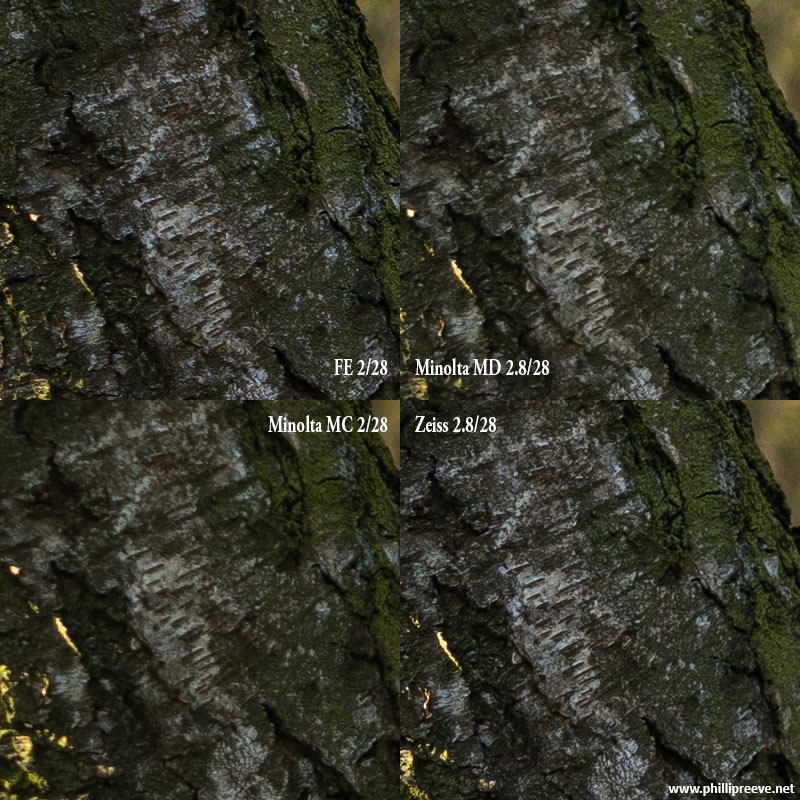
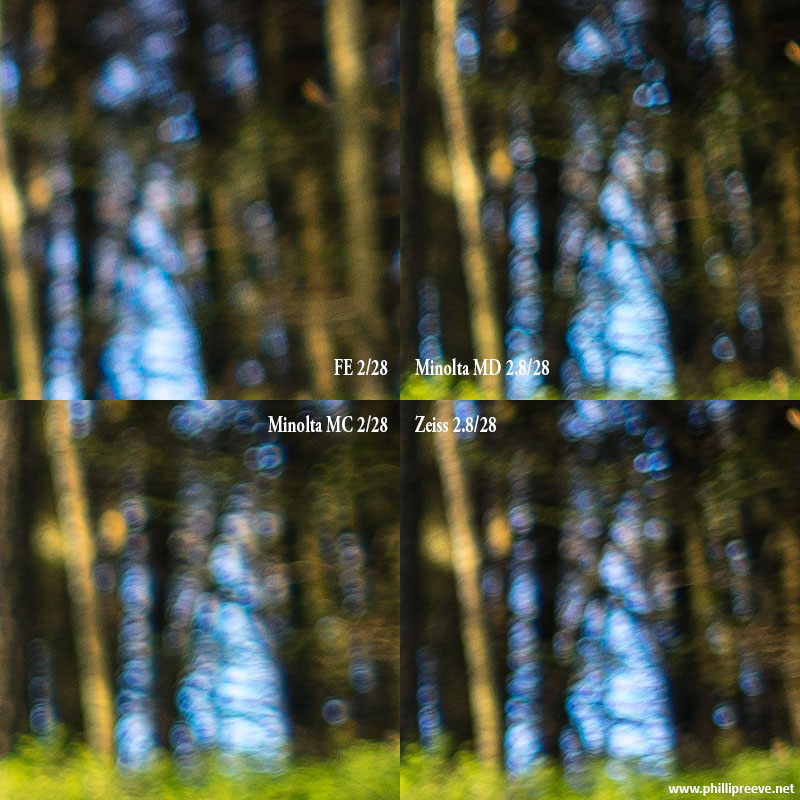
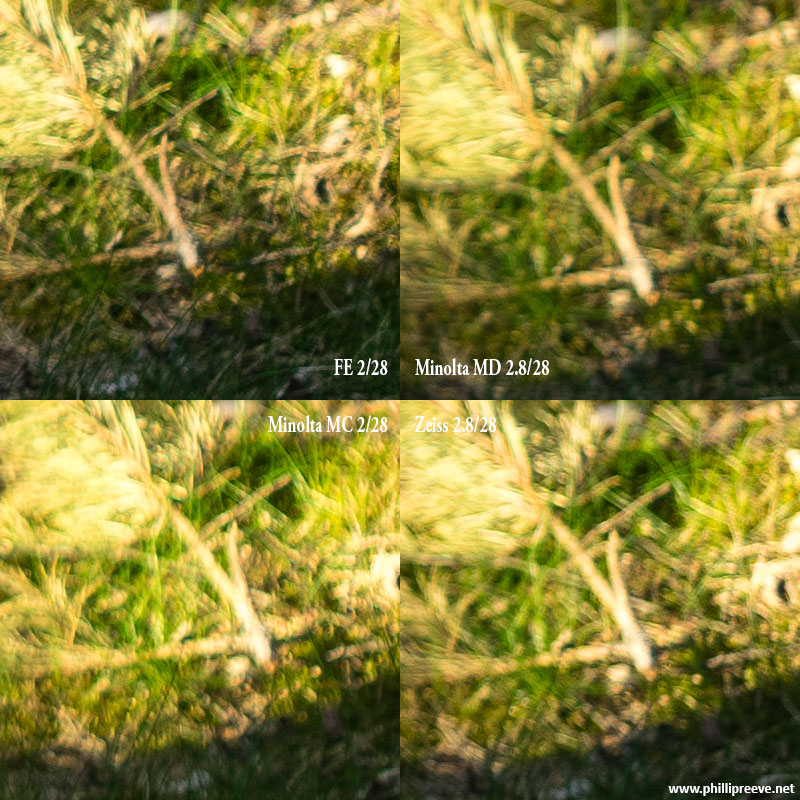
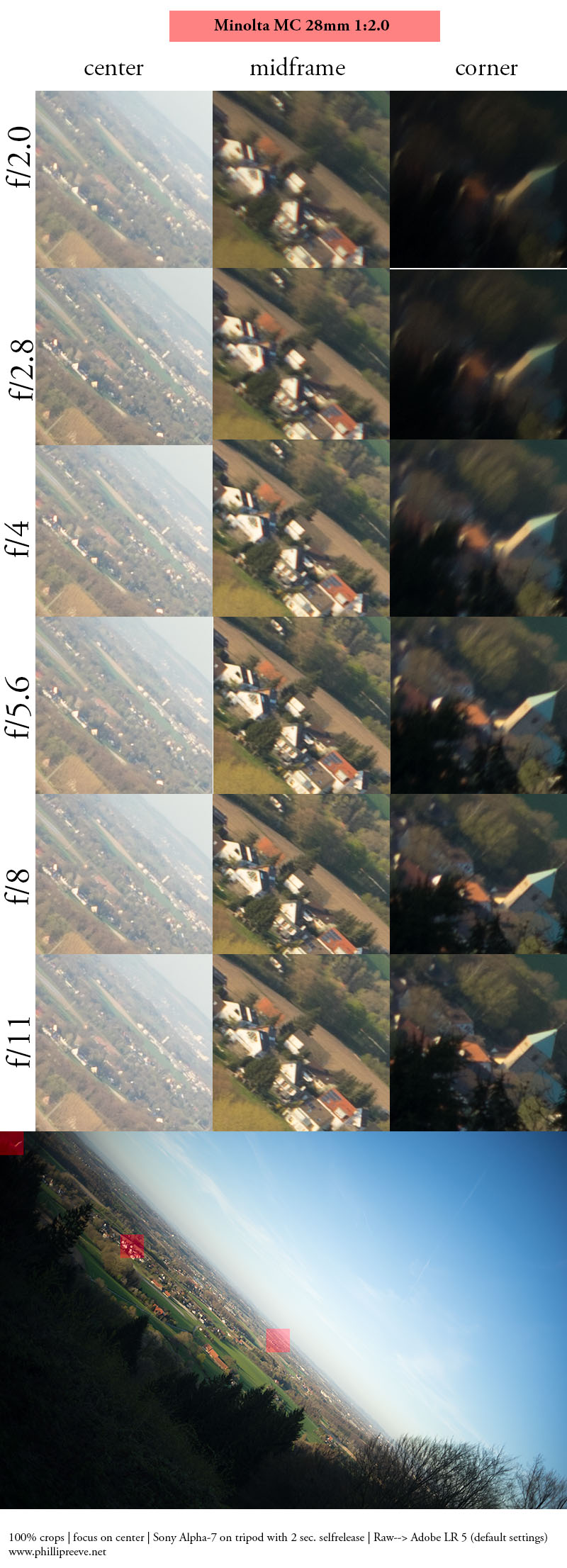
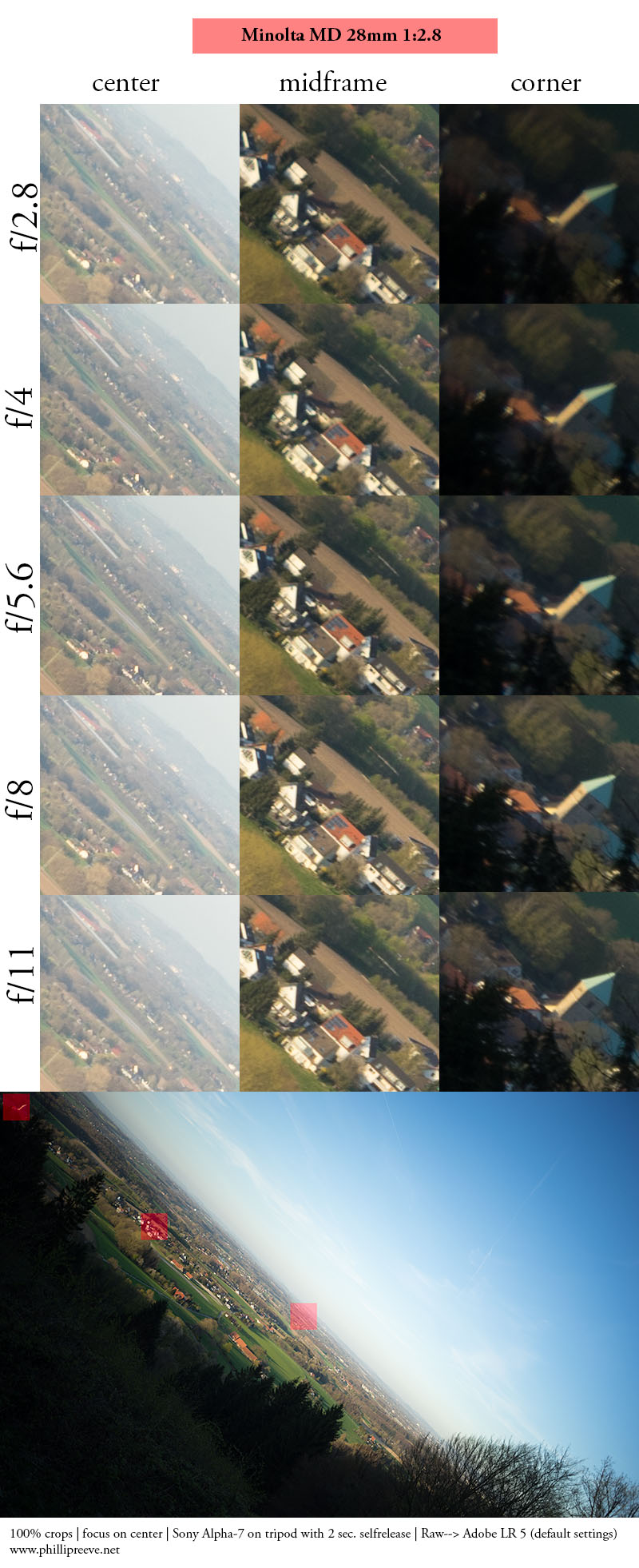
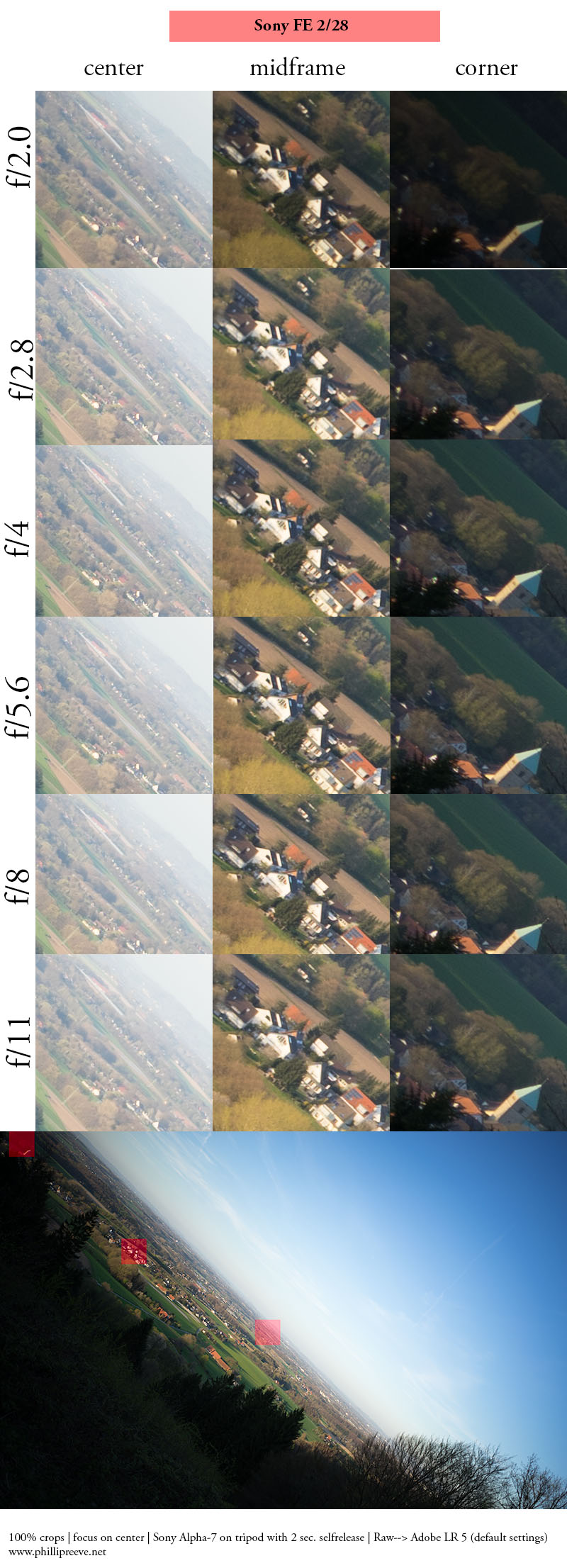
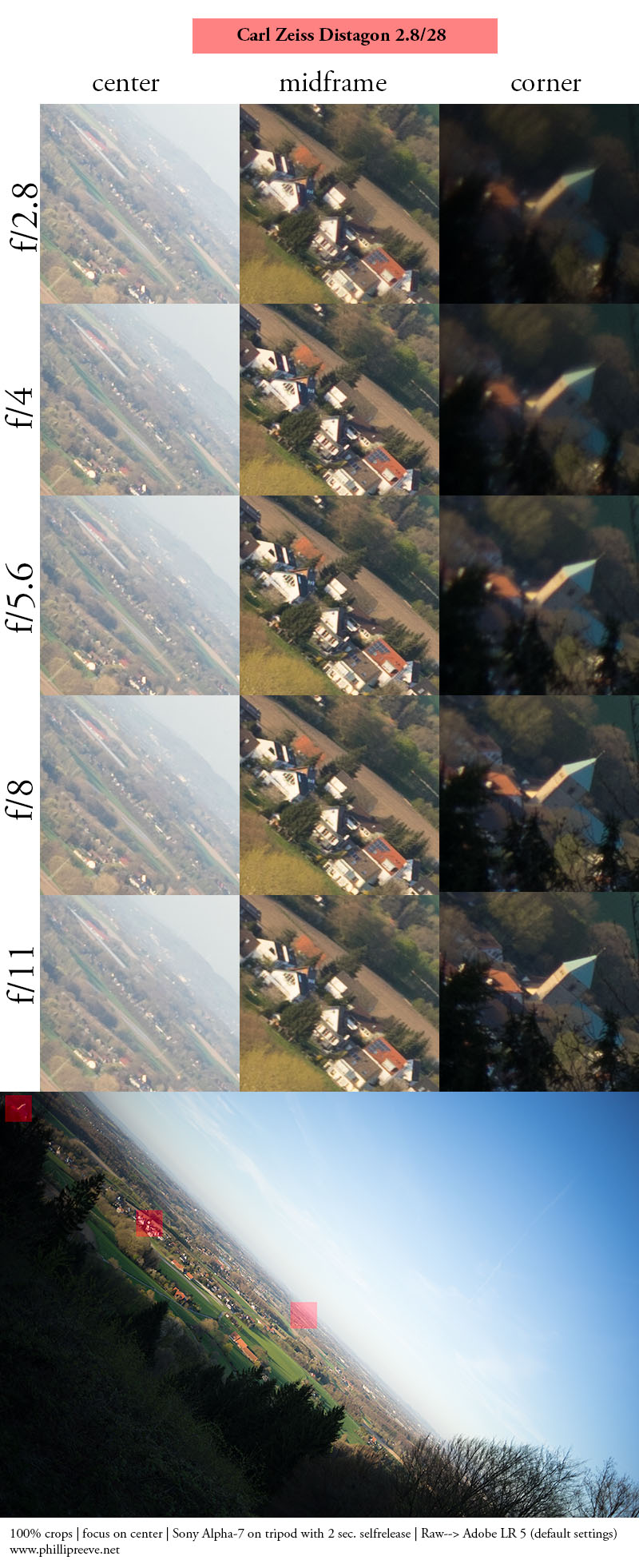
Thank you for your test. I get the same results with the Elmarit R 28mm and Elmarit M 28mm. The winner is the FE 2/28.
Jürgen
Well done & Thank you!
you are welcome 🙂
Danke Phillip für den aufschlussreichen Test, besitze selbst das Minolta MD 28mm 2.8 und interessiere mich für das FE 28mm. Dein Test hat mir bei der Entscheidung geholfen!
Thank you so much Philip, great comparison. I know these take quite a lot of work. Well done. I am a fan of Contax lenses on my A7/A7R. I was gifted the 25 2.8 and while I enjoy it, I do notice that when the sun is in the scene, the flare can be a bit much. I always suspected the 28 2.8 would have the same issue, but always tried to weigh that against the benefits you so well described here. With the release of the Sony 28 F2, I had many more factors to consider. Thank you for helping to make the choice. I think the benefits for the modern Sony outweigh its shortcomings as well.
Thanks Jack,
I think the Zeiss 2.8/28 is very flare resistant but the FE is even less flare resistant
In your conclusion you stated, “The Sony FE 2/28 performed remarkably well in this test, it has by some margin the best bokeh and it is as sharp as the Zeiss 2.8/28 with even better corners. It also is the most flare resistant.”
Responding to my comment you said, “I think the Zeiss 2.8/28 is very flare resistant but the FE is even less flare resistant.”
Is this an addendum to your conclusion? From your conclusion it sounds like the FE is the most flare resistant. Just curious….
I meant even more flare resistsant 😉
sorry for the confusion
The Carl Zeiss Distagon 28mm ƒ/2.8 T* doesn’t have any issues with flare, even when you shoot right into the sun:
https://flic.kr/p/rNpooH
https://flic.kr/p/ACm9M2
While I agree that it is very flare resistant I woudn’t go as far as to say that it is free from any ghosting, here is an example: https://www.flickr.com/photos/birnenbaumgarten/23496049792/in/album-72157651696491768/
Well, if you shoot ANY lens right into the sun in fog like that, it will show similar behavior. Actually I like that flare in your picture…
But I agree with you: no lens is completely flare resistant – under some circumstances you’ll get any lens to flare…
Most of my shots – especially portraits – are backlit, so I tend to ntice which lens flares easily and which one doesn’t…
Hallo Phillip,
danke für den aufschlussreichen Vergleich!
(Da bin ich erst noch mal mit meinem Distagon zufrieden)
Allerdings sehr gespannt, was da an LOXIA-Weitwinkel kommt!
Übrigens ist das (sehr günstige) Olympus OM 28/3,5 auch eine schöne
Landschafts-Linse, weil es recht gleichmäßig (Mitte und Rand)
scharf zeichnet.
Utz
Utz,
Ich hab´dich gesucht.
Bitte schreib mal.
//E aus Schweden
Just one more thing – you have the SEL-16-35Z now. How does it compare? High-quality zoom vs. affordable prime.
I will of course compare them, but it will take another week or so 😉
I would love to see that comparison too!
I understood that the Distagon 2.8/28 has in some points advantages over the FE 2/28.
I have have compared it on the A7 against the kit zoom at 28mm. The Distagon performed significantly better, especially in sharpness seen over the whole frame. Further colour rendering was more pleasant.
Reading your review and watching your sample pics, I get the feeling, that I would have no significant advantage in replacing the Distagon by a FE 2/28? There are pros and cons for both lenses. Maximum aperture and wide open performance in wide angle photographing for me is not really imporant, for I usually stop the lens down.
Am I right in this opinion based on reading your review? You have now some experience with both lenses and have compared them sorrowful. What is your opinion and what would be your recommendation?
If bokeh doesn’t matter to you and size is not important as well then the Zeiss is the better lens for you.
I think so too – the Distagon is an awesome performer:
https://www.flickr.com/photos/mike-mkvip/albums/72157651408623140
Thank you Phillip for the detailed test and for answering my question. I will mainly use the Contax Distagon in panorama photography. Bokeh in this application is a secondary. Color rendering and sharpness over the whole frame are more important criteria. As well low distortion is of interest.
Meanwhile I own as well the 4/16-35 and will compare the two Distagons (f2, Distagon and more common f2.8) with the Sony Zeiss zoom. Hope you will include the surprinsingly good performing Contax Distagon in your coming comparison, too.
This is a fantastic review and much appreciated. Given the low cost of the MC 28mm 2.8 I bought it. Out of all the MD/MC lenses I’ve purchases it’s my favorite. However, the bokeh is harsh when it does show up and the contrast isn’t the best even when stopped down. For the bokeh alone I’ll be buying the FE. For the price those manual lenses go for- I’d suggest just owning them all!
I picked up the Zeiss Distagon 2.8/28 at a good price from eBay last year and love it. It’s a remarkable lens and well suited for the Sony A7R. I may just stay with this one!
Schöner Vergleich!
Nur eine Frage dazu: Ist das Minolta MD 2,8/28 der 7- oder der 5-Linser?
der 7-Linser
Welches Distagon 28/2.8 hast Du genutzt, Phil? Vielleicht die alte AE anstatt
der neueren MM Version? Wurde eine Geli am Distagon benutzt? Denn das FE 28/2.8 hat ja via Haus aus eine…ansonsten wäre es ein etwas unfairer Vergleich…ferner ist
das Distagon ja nur mit max. 2.8 Blende ausgerüstet….dennoch im Top Zustand für wesentlich weniger Geld als das FE 28/2.8 zu bekommen – ich habe mein MMJ jetzt seit Herbst 2013.
Sind die beiden Versionen nicht optisch gleich? War aber ein MM.
Keine Geli am Distagon, in dem Szenario wird die aber keinen Unterschied machen, die wirkt sich nur bei Lichtquellen knapp außerhalb des Bildes aus. Deshalb halte ich den Verleich auch nicht für unfair.
Wenn es nur um Landschaftsaufnahmen geht ist das Distagon ein tolles Objektiv.
It is not a fast 28mm but you should try the SMC Pentax 28 3.5 , K version not M version. It is a very good landscape lens. I would like to see how it performs vs this new Sony.
can you give me a link how to identitfy the k version?
Maybe it’s this version:
SMC Pentax 28mm F3.5
http://www.pentaxforums.com/lensreviews/SMC-Pentax-K-28mm-F3.5-Lens.html
on m-version is written pentax-m
http://www.pentaxforums.com/lensreviews/SMC-Pentax-M-28mm-F3.5-Lens.html
thanks for the link
Hi, Phillip… I have just become a happy A7 (+ ‘complementary’ A5000, 51-shutter count ‘refurb’) owner in the past 48 hours, and I am so pleased to now have this site as a resource for my photographic interests. As a Nikon user in the film era… “on hiatus” from all photography activity for 21 years… and a Pentaxian in my return to the game with digital gear, I can speak to both systems with some knowledge and, perhaps, some useful maturity. I can confirm the information you were given above for the “SMC Pentax 28mm f.3.5”, and it is exactly this designation, despite many misnomers on eBay, which is correct for the first Pentax lenses of the K-mount era (still going strong and, uniquely, fully back-compatible through the M-42 screw mount models for such subjects as landscape, nature, and cityscape). It is a fair assessment to characterize Pentax, then and now, as an “in the field” oriented system. It was the range of fully useable primes that compelled me to move on from the Nikon fold within the APS-C realm. Now new doors are opening up!
The “K” designation for identifying the first, and in many cases best of the bayonet mount lenses is simply an unofficial addendum to make reference easier… much as the “N” designation is sometimes used to mark pre-AI Nikkors of the last series before auto-indexing was initiated. So, the Pentax MF series of K-mount lenses goes in this sequence: SMC Pentax… SMC Pentax-M (the compact models)… and SMC Pentax-A (electronic contacts added to “modernize” functionality). Build quality went somewhat downhill from series to series, following the modern trend.
When it comes to the most discussed, most generally capable and practical gems for landscape work, these stand out for full frame: SMC Pentax 20mm/4 (depending on your requirements from vintage ultra-wides)… SMC Pentax-A 24mm/2.8 (some issues with corner definition)… SMC Pentax 28mm/3.5… SMC Pentax 30mm/2.8 (rarely seen, but sought after and thought of more accurately as a 31mm lens)… FA 31mm/1.8 Limited (AF, screw drive, and closer to 32mm — price-y)… DA 40mm/2.4 Limited (an “APS-C” lens which covers full frame, sharp corner-to-corner, notably holding up very well at f.11 vs. diffraction effects); or its cheaper DA 40mm/2.4 XS variant… FA 43mm/1.9Limited* (“quirky” in a good way for those who know how to use it to best advantage)… and the various, versatile f.2.8 50mm macro models, the best being the SMC Pentax-F from the first auto-focus series, or the “refreshed” SMC Pentax-FA. These two have a poor focus ring design and awkward feel for manual focusing, however.
Also noteworthy is the DA 35mm/2.4, which is the “plastic fantastic”/budget rendition of the FA 35mm/2.0, modernized from the same true full frame film era formula. It might arguably be said to be a somewhat more “refined”, if slightly slower lens, with respect to abberations than something like a Nikon 35mm/1.8 G or a Canon “pancake” for crop sensor (but again, this one was effectively designed for FF). Obtainable so cheap, and being so lightweight, it can make carrying both a 40mm, like the pancake Limited or the faster CV 40mm/2.0 Ultron SL II, plus a 35mm no particular burden for anyone inclined to sometimes carry both FL’s (for instance, when using the Sony 28mm/2.0 FE with the A7, accompanied by a fast MF-ing 40mm — for the purpose of having an AF ‘wide-normal’ option on an accompanying DSLR — a pixel-shifting K-3 II, perhaps?).
So I hope that overview helps you and some of your readers a bit. While the FA Limiteds are still a bit price-y used — particularly the 31 Limited — secondhand price histories for all can be viewed at the Pentax Forums website in the lens database. Here are some ‘good’ prices currently from the list above for very clean examples: 24mm – $130-170… 28mm/3.5 – $95-125+… 30mm – $240-300+ (?)… DA 35mm – $115-125… 40mm Limited – $225 (a bit more in the newer HD-coatings form) & 40mm XS – $115-135. The circa $120-used DA 50mm/1.8 is another good, inexpensive, & super-lightweight full frame lens disguised as an APS-C only model. DA lenses require an aperture-controlling adapter.
The SMC Pentax-M 35mm/3.5 is an entirely different optical formula (as is the preceding M-42 S-M-C Takumar 35mm/3.5), and it has its own rendering — good, but not to be confused in the enthusiasm among Pentaxians for the older model. I, too, would strongly urge trying out Philippe’s suggestion if you can, Phillip, along with the DA 40mm/2.4 Limited on your A7 at f.5.6 through f.11. Both of these fine lenses have simply been flying below most folks’ radar, as does much that’s pretty good and unique about Pentax. I’m laid up at present — temporarily — so my own testing must wait for awhile — 28mm SMC-[K], 28mm/2.0 AI Nikkor, 31mm Ltd., DA 35mm, 35mm/2.0 Nikkor Q.C., 40mm Ltd., and 40mm Ultron SL II AI-P in this range. This A7 thing is definitely going to be fun. I’ll ‘clean house’ down to some practical realization of my options once I get a handle on how all this now fits into a sensible plan!
thanks a lot for the extensive list! Pentax lenses have been more or less of my radar so far but I am sure I will test some of them in the future!
I really wish you had a nikon 28mm 2.8 ais. It is supposed to be legendary and can be had for less than 200 with Soon patience. I have one that is wicked Sharp but I wanted to Compare it to the Sony. I was thinking I could just keep it and get the 35mm 2.8 but I would love a 28 mm AF for those Situations at a event that a 35 might not be wide enough.
From the reports I have read the Nikkor is great at shorter distances but performance decreases at longer distances. Since I am still very happy with the Fe 2/28 and also own the Zeiss 2.8/28 my curiousity is not so great that I would activly hunt for the Nikkor but if an opprtunity arrises I will take it 😉
Rolleinar 28mm f2.8 is arguably as good as Zeiss and perhaps even better colors. Try it if you haven’t.
Do you mean the 8/7 or the 7/7 Version? Can you link to any additional info about it? I found very little information on google
Here is some information on the Rolleinar: http://forum.mflenses.com/userpix/20113/big_517_majg343_1.jpg
I really appreciate the work and passion you put into your reviews. It would be interesting to see how the Minolta 28mm 2.5 SI would fair. Here is an interesting sampling… http://artaphot.ch/sony-nex/altglas/341-sony-a7-and-classical-rokkors
Hi
thank you for the detailed test and review.
I am still – and my be will be for a longer time – a beginner in the field of drawing light…
My question is, how you test performance of the old manuell lenses. I own them two since I wanted to dig into the field of product photography with a small budget. Yes, I know, I should start with at least 50mm + crop but…
In a nutshell, all I can do is start with shutter priority since I set apterature manually via the lense’s ring… and have to focus manually, too. So where is the performance?
thanks alot
PS:
got only a Nex 5N
I sent you a mail 😉
Hi Phillip, and what can you say about Nikkor AIS 28/2,8?
Best regards.
Not much since I have never used it. I have read that it is very good at shorter distances and it can focus quite close. At infinity it is supposed to be a bit weaker.
Thanks for testing out these lenses 🙂
The Zeiss Contax 28mm f2,0 (aka Hollywood) kills the Sony FE, but as you already showed the f2,8 is not as good.
Do you have any sample shots of the 28 Hollywood on Sony FE cameras? Would love to see them, I’m thinking of buying one for my A7RII…thanks!
we have a full review: Zeiss 2/28
Hi, Phillip!
Just like to add that IMHO the MC 2.8/28 is a better lens than the MD 2.8/28 – and the MC is also very cheap (but a little bigger than the MD).
From other sources I have read that there are basically two different versions as far as the optics are concerned. The first one had seven elements was introduced in 1974 as MC-X and later updated to MD. It was sold until 1983 when the second version with only 5 elements was introduced as plain MD. I have a MD Rokkor 2.8/28 and a plain MD 2.8/28. Both give me a not very competitive performance but it might be that I have bad copies. If you could share some full resolution samples that would be great.
Any idea how the se compare to voigtlander ultron 28mm f2?
All I know about the Voigtlander is from Bastian’s review so my guess is as good as yours
And I haven’t used the others, so my guess isn’t any better 🙂
I have a Md, used here for this review and I was willing to spend some money for the 28 f2 since I read was “the best 28 mm!” sharp all across and bla bla bla,…..well, I’m wondering now if I should withdraw my bid :/,….and just buy one of those zeiss. Actually ebay is full of that zeiss and the minolta is a hard to find….interesting..
Ulala!! what to do! 🙂
Depends on what you are looking for but if sharpness and contrast are your main concern the Zeiss ist without a doubt the better choice
Thank you for the comparison! Very useful. I have found the Zeiss in a local shop here (with 3months warranty) for 230 Euro. On the other hand, I would like a faster lens like the Sammy 24mm F1.4 E-Mount. Have you tested this lens?
I know the price is twice, the Samyang costs like the Sony.
Ty
The Samyang is too heavy/large for my taste.
Hmm true, you are right. Then filters might be quite expensive since it’s 77mm. I think I will go with Zeiss
Thanks!
Hi Philip, great test, One question, if you correct de Sony for distortion, is it still sharper than the Zeiss in the corners?
As far as I remember it is not, only in the extreme corners
Hi Philipp, nice comparison you made there. I got a question for you, i bought the MC 28mm 2.8 but sharpness area is around 5-30cm. I can’t get it sharp towards infinity. Is there something wrong with the lens? I use the K&F adapter.
best regards
Do you have any orher Minoltas?
Just stumbled upon this post while researching Minolta legacy lenses and noticed that you mentioned yours had fungus. I recently started using a Minolta Rokkor 50mm/1.7 lens that belonged to my mother. It definitely has a large spider web patch of fungus in the glass. However, I am quite attached to it because it allows me to feel connected to her, but I worry about whether or not it could “spread” to other lenses or the camera itself. Of course, the internet offers many, many opinions on the topic. Do you still use your lens?
Still sits in my cabinet. After some research I came to the conclusion that as long as you store it right fungs won’t spread and if it is too humind spores will find your lens, no matter what.
Thanks for this useful review! I have the Sony A6000 and I use the Contax Distagon 28 2.8 for street photography.
According to your experience,the differences between Contax 28 f2,8 and Sony 28 f2 are the same also with an aps c sensor?(lot more density)
I’m looking for an autofocus lens but I don’t know how much modern lenses are better ( in terms of sharpness)
Thanks
Modern lenses are not really better (except the Loxia 2.4/25 maybe). We haven’t really used these on APS-C.
Hello Phillip, the link: https://phillipreeve.net/blog/sony-fe-28mm-2-what-we-know-so-far/
will not work….
Thanks
Klaus
Hi. Nice and interesting post! Anyway, I believe that your Minolta f2 lens tested here is not at its best.
There must be heavy variation between specimen. My Minolta 28mm f2 is outstanding. It is way sharper than in your test. It is my favorite lens.
My 24mm Zuiko f2 on the other hand is softer.